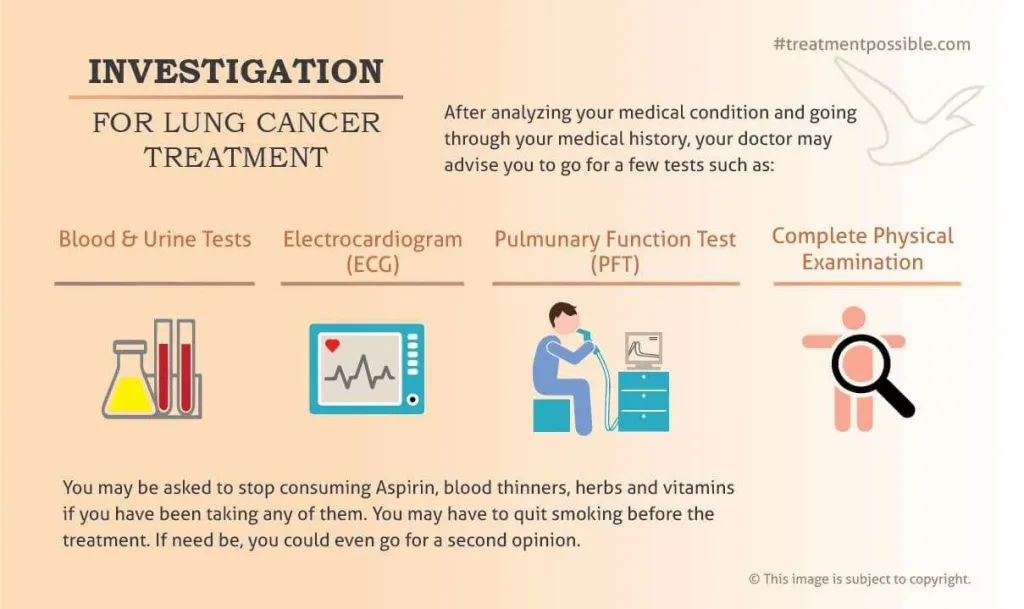About Lung Cancer
Verified By: Dr. Donald John Babu (MBBS, MS, FCPS, MCh – Surgical Oncology, MRCS (UK), FICS)
Navigate To:
- Navigate To:
- What is a Lung Cancer?
- What are the Lung Cancer Types?
- Did you know?
- What are the Causes and Risk Factors of Lung Cancer?
- What are the Lung Cancer Symptoms?
- Do you think you have any of the above symptoms?
- How is Lung cancer Diagnosed?
- What are the Stages of Lung Cancer?
- Want more clarification about medical expense & treatment plan?
- Frequently Asked Questions:
What is a Lung Cancer?
Lung cancer is one of the leading causes of cancer worldwide which starts in the lungs. Your lungs are two spongy organs in your chest which helps you inhale oxygen and release carbon dioxide when you exhale.
What are the Lung Cancer Types?
There are 2 types of lung cancer. The most common type of lung cancer is non-small cell lung cancer (NSCLC).
- Small Cell Lung Cancer: Small cell lung cancer occurs in heavy smokers. The small cell lung cancer (SCLC) grows and spreads faster than NSCLC and this responds to chemotherapy.
- Non-Small Cell Lung Cancer: The non-small cell lung cancer (NSCLC) usually forms in the outer part of the lungs (adenocarcinomas). This type is not aggressive and does not invade the surrounding tissue. Non-small cell lung cancers include squamous cell carcinoma and large cell carcinoma.
What are the Causes and Risk Factors of Lung Cancer?
- Smoking – Cigarette smoking is the major cause of cancer about 90% of those who get Lung cancer would not get it if they did not smoke. A smoker’s heart works harder than a non-smoker’s. The heart averages eight to ten more beats per minute during the day and three to five more beats during sleep.
- Exposure to secondhand smoke – Apart from cigarettes, cigar and pipe smoking, breathing the smoke of other smokers will also increase the risk of lung cancer.
- Tobacco products contain more than 6,000 chemicals, of which at least 60 are known to cause cancer.
- Previous Radiotherapy – If you have undergone Radiotherapy to the chest earlier, then you may have an increased risk of developing lung cancer.
- Family History of Lung Cancer – Inherited genetic mutations may make you more likely to develop lung cancer.
- Exposure to radon, a naturally existing radioactive gas increases the risk of Lung cancer, for eg. uranium miners are exposed to radon.
- Asbestos exposure – It has been noted that asbestos workers are more prone to lung cancer and an otherwise rare chest tumor called mesothelioma (A type of lung cancer). The disease develops due to years of exposure to asbestos fibres.
Other substances that can cause lung cancer are:
- Arsenic
- Cadmium
- Chromium
- Nickel
- Some petroleum products
“The National Research Council has concluded that the air in the city is 15 times more polluted than the air in the countryside. As the report said, lung cancer is the most common in city areas where general industrial pollution is worse.”
What are the Lung Cancer Symptoms?
The symptoms of non-small cell lung cancer and small cell lung cancer may include:
- Lingering or worsening cough
- Coughing up phlegm or blood
- Chest pain worsens when you breathe deeply, laugh, or cough
- Hoarseness
- Shortness of breath
- Wheezing
- Muscle weakness and fatigue
- Loss of appetite and weight loss
- Recurrent respiratory infections like pneumonia, bronchitis etc.
- Tumors at the top of the lungs will affect facial nerves, and lead to drooping of one eyelid. These symptoms are called Horner syndrome and it can also cause shoulder pain.
- Tumors could press on the large vein that transports blood between the head, arms, and heart. This causes swelling of the face, neck, upper chest, and arms.
Back pain could be due to the pressure of large tumors growing in the lungs. It can also mean that cancer has spread to your spine or ribs. As it grows, a cancerous tumor could cause compression of the spinal cord which can lead to neurologic deterioration causing the following:
- The weakness of the arms and legs
- Numbness in the legs and feet
- Urinary and bowel incontinence
- Interference with the spinal blood supply
However, Back pain may improve if treatment such as surgery, radiation, or chemotherapy can successfully remove or shrink the tumor.
Do you think you have any of the above symptoms?
We will help you to consult a doctor for Lung cancer Treatment in India.
How is Lung cancer Diagnosed?
After a physical examination, your physician will instruct you to prepare for specific tests, such as:
- Imaging tests: An abnormal mass and smaller lesion can be seen on X-ray, MRI, CT, and PET scans.
- Sputum cytology: If you produce phlegm when you cough, microscopic examination will determine if cancer cells are present.
- Biopsy: A biopsy can determine if the tumor cells are cancerous or not. A tissue sample could be obtained by:
- Bronchoscopy: under sedation, a lighted tube is passed down your throat and into your lungs, for closer examination.
- Mediastinoscopy: The physician makes an incision at the base of the neck and surgical tools are used to take samples from the lymph nodes. This is generally performed under general anesthesia.
- Needle: Using imaging tests as a guide, a needle is inserted through the chest wall and into the suspected lung tissue. Needle biopsy could also be used to test lymph nodes.
Tissue samples are sent for analysis and if the result is positive for cancer, further testing, such as a bone scan, can help to determine the stage of the cancer and the spread of cancer.

What are the Stages of Lung Cancer?
Non-small cell lung cancer has four main stages:
- Stage 1: Cancer is found inside the lung and not outside the lung.
- Stage 2: Cancer is found in the lung and near the lymph nodes.
- Stage 3: Cancer is found in the lung and lymph nodes in the center of the chest.
- Stage 3A: Cancer is found on the same side of the chest in the lymph nodes.
- Stage 3B: Cancer has spread to lymph nodes on the opposite side of the chest or to lymph nodes that are above the collarbone.
- Stage 4: Cancer has spread to both lungs and the surrounding area around the lungs, or to the distant organs.
Small-cell lung cancer (SCLC) has two main stages which are limited stage and extensive stage.
- Limited Stage: Cancer is found in only one lung or near the lymph nodes on the same side of the chest.
- Extensive stage: Cancer may spread throughout one lung, to the opposite lung, to the lymph nodes on the opposite side, to the fluid around the lung, to the bone marrow and to the distant organs.
Want more clarification about medical expense & treatment plan?
Plan Your Lung cancer treatment In India
